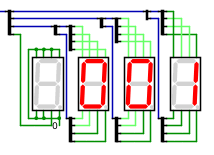4. Assignment 4
Worth: 5%
DUE: Friday April 4, 11:55pm; submitted on MOODLE.
4.1. Provided Files
Incomplete Digital, hex and esap files are provided for the questions.
These files can be downloaded from here.
Uncompress this folder and open the files as necessary. Each question specifies which of the file to work in.
4.2. Part 1 — Machine Code
Note
External programs can be added to RAM within Digital through Edit -> Circuit specific settings -> Advanced. Select the Preload program memory at startup checkbox and navigate and the select the desired hex file for the Program file field.
Write a machine code program to animate
1“bouncing” across the output display on repeat, as seen belowFor this question, use the provided “1-ESAP.dig” system for running the program
Write the machine code program in the provided “1-bounce.hex” file

Demonstration of the number
1“bouncing” across the output display.Create a new “bouncing” program such that the delay between each step of the animation is the same
Due to jump, the time delay between the updates to the output register is likely inconsistent
Change the program such that there is an even time delay between each update
If the solution to the previous question already addressed this, simply repeat it here
For this question, use the provided “1-ESAP.dig” system for running the program
Write the machine code program in the provided “2-bounce_timing.hex” file
Write a program to calculate and output the result of
55 + 66and55 - 50For this question, use the provided “1-ESAP.dig” system for running the program
Write the machine code program in the provided “3-arithmetic.hex” file
4.3. Part 2 — New Instructions
Because outputting a value requires saving it to RAM before it can be displayed (SAVA + OUTU, for example), it
effectively takes up 2 RAM addresses. This may become problematic as the system only has 16 bytes of RAM.
Create two new instructions to output an unsigned or signed integer directly from the A register
Have
0b1011and0b1100be the instructions for an unsigned and signed integer respectivelyThese instructions take no operand
Modify the contents of the look up table in the provided “4-ESAP.dig” file to add the new instructions
Hint: Use a script to generate the hex values for the control logic look up table
Using the new instructions, calculate and output the result of
55 + 66,55 - 50, and66 - 55This must be done in a single program
Use the modified “4-ESAP.dig” file from the previous question for running the program
Write the machine code program in the provided “5-arithmetic_big.hex” file
4.4. Part 3 — Eliminating Clock Cycles
Currently, each instruction within the system always takes 4 microcode steps (clock cycles), even if the instruction
only really needs 3. For example, consider that the LDAD instruction only needs the 2 fetch steps + 1 more step to
output from the instruction register and input into the A register.
Modify the ESAP design and instruction set such that instructions complete in 3 clock cycles, where possible
For this question, do not include the new output instructions from the previous part
This question requires modifying the hardware of the ESAP system and the control logic look up table
Use and modify the provided “6-ESAP.dig” file
Use a script to generate the hex values for the control logic look up table
Although there is an argument for leaving
NOOP4 clock cycles, make it take 3 here
4.5. Part 4 — Assembly
Writing simple programs in machine code is arguably not too difficult, but remembering machine code is a tedious task. When solving more complex problems, eliminating unnecessary difficulty helps improve the programming experience.
Write a program in the ESAP assembly language that can divide 2 numbers and output the result
To simplify things, assume
The numbers are evenly divisible (no remainder)
Only positive integers
The answer will always be at least
1(one would not ask0/5, for example)
Have the dividend and divisor be in addresses 14 and 15 respectively
For this question, use the provided “7-ESAP_conditions.dig” system for running the program
This solution will not make use of the modified ESAP systems from the previous questions
No new instructions or 3 microcode step instructions
Write the assembly code program in the provided “7-divide.esap” file
Use the provided “assembler.py” to assemble to machine code
4.6. Some Hints
Work on one part at a time
Some parts of the assignment build on the previous, so get each part working before you go on to the next one
Test each design as you build it
This is a really nice thing about these circuits; you can run your design and see what happens
Mentally test before you even implement — what does this design do? What problem is it solving?
If you need help, ask
Drop by office hours
4.7. Some Marking Details
Warning
Just because your design produces the correct output and the tests pass, that does not necessarily mean that you will get perfect, or even that your design is correct.
Below is a list of both quantitative and qualitative things we will look for:
Correctness?
Did you follow instructions?
Label names?
Design, layout, and style?
Did you do weird things that make no sense?
4.8. What to Submit to Moodle
Submit your modified ESAP Digital (.dig) files to Moodle
Submit your completed hex files for the machine code programs
Submit your completed esap file for the divide assembly program
Submit the hex files for modifying the look up tables
Do not compress the files before uploading to Moodle
Warning
Verify that your submission to Moodle worked. If you submit incorrectly, you will get a 0.